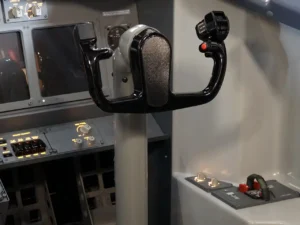The control yokes, rudder pedals, and steering tiller are also essential elements for the flight simulator. If a flight simulator was constructed in stages, it is possible to delay installation of the flight controls for the first officer’s side.
Unlinked vs. Linked vs. Motorized Flight Controls
When building a home flight simulator, there is a decision that must be made regarding the flight controls prior to building the simulator platform. The least expensive option for dual unlinked flight controls if for the captain and first office’s control yoke and rudder pedals. The captain’s and first officer’s controls would operate independently. The simulator software is then configured to blend control inputs. In real-life aircraft operation, only one pilot should be controlling the flight controls at any time. Therefore, having independent flight controls is a reasonable and inexpensive option.
The captain and first officer flight controls can be mechanically linked, as they are in the real aircraft. Any control yoke or rudder pedal movement on one side is reflected by movement of the flight controls on the other side. This adds a modest level of increased realism to the simulator, but it also adds substantial cost and complexity. It requires substantially increasing the thickness of the flight simulator platform to accommodate the mechanical linkages (cables, pipes, rods) needed for physically connecting the controls. Additionally, the cost of linked flight controls is significantly higher in comparison to unlinked controls.
A third option is loaded and motorized flight controls. This approach uses hydraulic pistons to provide resistance to control displacement from the center neutral positions when in manual flight. In automatic flight, the flight controls move to reflect the autopilot control commands. This is realistic with how the real aircraft operates, but this capability requires a huge investment in cost and complexity for both the hardware and associated software. Consequently, it is uncommonly used for home flight simulators.
Control Yokes & Rudder Pedals
This simulator uses unlinked control yokes and rudder pedals from Precision Flight Controls for both the captain and first officer. The control yokes are the Jet Liner Column Yoke – Boeing 737 model and the rudder pedals are the Cirrus Rudder Pedals – Boeing Style model. These controls are close to the appearance of the real B737 aircraft flight controls. They include buttons for the stabilizer trim (dual switches as in the real aircraft), autopilot disconnect, radio transmit, etc.


The controls interface with the computer via a USB connection that emulates a game device to provide analog control position. The rudder pedals were custom upgraded with Leo Bodnar BU0836A 12-bit controller USB interface cards for greater fidelity.
Steering Tiller
This simulator uses a Flight Deck Solutions B737NG PRO-MX Steering Tiller. It is installed on the left side of the flight deck, just to the left of the captain’s seat. Interfacing is via a Leo Bodnar BU0836A 12-bit controller USB card. A steering tiller is used for making turns when taxing on the ground. Rudder pedal deflection will only move the nosewheel a limited amount, so the steering tiller is necessary for shaper turning needing during taxi.

Flight Control Installation
Precise positioning for the installation of the flight controls and steering tiller in the flight deck was done by referencing published real aircraft measurements, to include www.markuspilot.com, as well as other sources.



